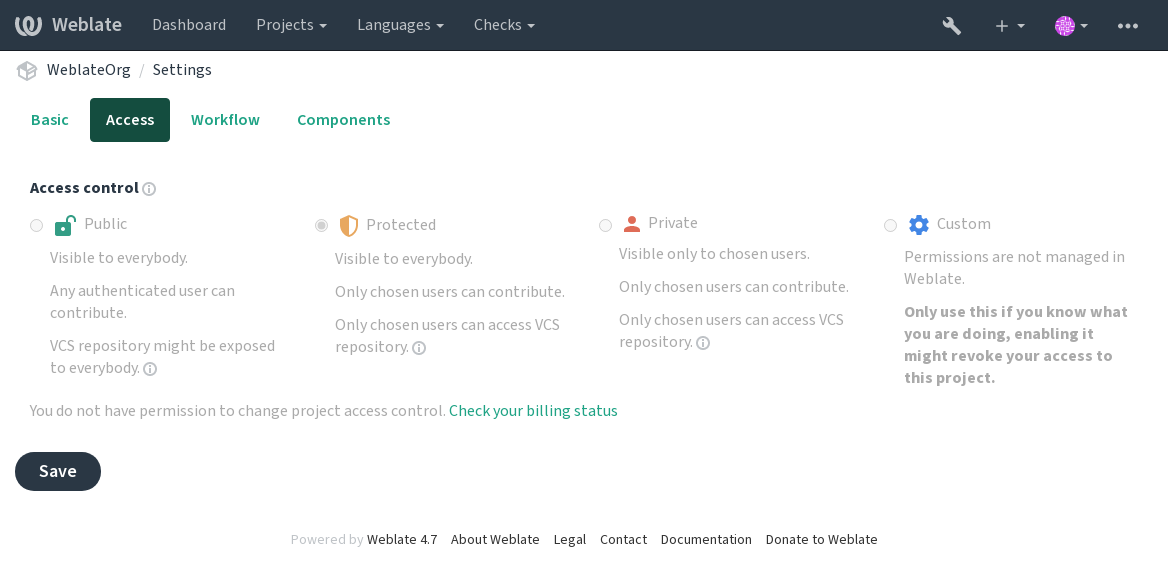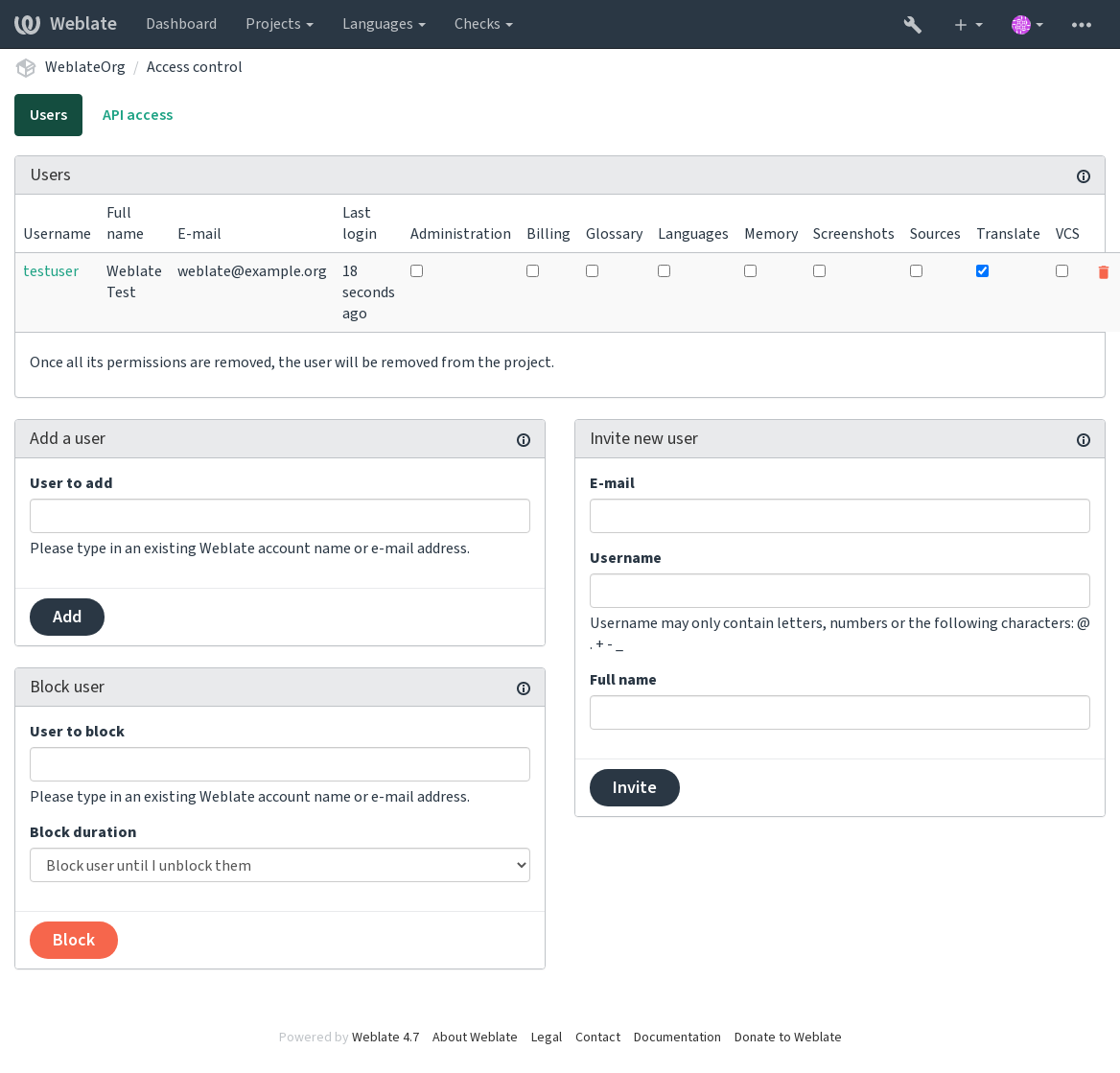访问控制¶
Weblate 带有细粒度的特权系统,可以为整个实例或在有限范围内分配用户权限。
在 3.0 版更改: 在 Weblate 3.0 之前,特权系统仅基于 Django,但现在是专门为 Weblate 构建的。如果使用的是更旧的版本,那么请查阅所使用的特定版本的文档。
简单的访问控制¶
如果你不是掌控完整的Weblate安装,而仅仅是需要访问管理当前项目(如在Hosted Weblate <https://hosted.weblate.org/>`_),你的访问控制管理选项将被设置所限制。如果你不需要任何复杂的步骤,这些就足够了。
项目访问控制¶
注解
此功能对于运行 Weblate 上托管的自由软件计划的项目不可用。
您可以通过选择不同的:guilabel:`Access control`设置来限制用户对单个项目的访问。可用的选项有:
- 公开的
公开可见,且所有登录用户均可进行翻译。
- 受保护的
公开可见,但只允许被选择的用户翻译。
- 私有的
公开可见,但只允许被选择的用户翻译。
- 自定义
用户管理<manage-acl>功能将被禁用;默认情况下,禁止所有用户对项目执行任何操作。您必须使用:ref:`custom-acl`设置所有权限。
可以在每个项目的配置(:guilabel:`Manage↓:guilabel:`Settings)的:guilabel:`Access`选项卡中更改Access控制。

可以通过 DEFAULT_ACCESS_CONTROL 更改默认值。
注解
即使对于 “私有” 项目,也会公开有关项目的一些信息: 尽管具有访问控制设置,所有项目的计数都会包含在整个实例的统计信息和语言摘要里面。你的项目名称和其他信息不会暴露。
注解
项目中默认提供“公开”,”受保护”,及“私有”的用户权限组合, Weblate的实例管理员也可以使用:ref:`custom settings <custom-acl>`进行个性化定制.
警告
通过打开 Custom 访问控制, Weblate 会删除所有为一个选定项目建立的 special groups。如果你在没有整个 Weblate 实例的管理员权限的情况下这样做,你会立即丢失管理项目的权限。
参见
管理每个项目的访问控制¶
有 Manage project access 特权的用户(请参见 特权列表 )还可以通过 non-Custom 访问控制来管理用户。它们可以将用户分配到以下组之一。
关于‘公开’,‘受保护’,及‘私有’项目:
- 管理
包括项目可用的所有权限。
- 复查 (仅限 :ref:`review workflow <reviews>`设置为打开)
可以在复查时批准翻译。
只限‘受保护’及‘私有’项目:
- 翻译
可以翻译项目,并将离线的翻译上传。
- 源
可以编辑源字符串 (如果在 project settings 中允许的话 )及源字符串信息。
- 语言
可以管理翻译语言(添加或删除翻译)。
- 词汇表
可以管理词汇表(添加或删除条目,并上传)。
- 记忆存储
可以管理翻译记忆库。
- 截图
可以管理截屏(添加或删除截屏,并将其与源字符串关联)。
- 版本控制系统(VCS )
可以管理版本控制系统(VCS)并访问导出的仓库。
- 账单
可以访问账单信息和设置(请参见 账单 )。
遗憾地,暂时不能够更改这个预前定制好的列组。同时这方法并不能够给予所有用户加上一些额外权限。
注解
对于非“自定义”访问控制,实际上为每个项目定义了上述每个群组的实例。 这些组的实际名称将是“Project@Group”,也以这种方式显示在 Django 管理界面中。 尽管无法从 Weblate 用户界面编辑它们。

这些功能可在 Access control 页面上找到,页面访问路径为项目 menu Manage ↓ Users。
新用户邀请¶
此外,除了将现有用户添加到项目之外,还可以邀请新用户。 将立即创建任何新用户,但是该帐户将保持不活动状态,直到使用通过电子邮件发送的邀请中的链接登录为止。 不需要具有任何站点范围的权限,就可以这么做,项目级别的访问管理权限 (如,`Administration`组成员资格) 就足够了。
提示
如果被邀请的用户错过了邀请的有效性,则可以在密码重置表单中使用被邀请的电子邮件地址设置密码,因为已经创建了帐户。
3.11 新版功能: 重新发送用户邀请电子邮件是有可能的 (使任何之前发送的邀请无效)。
The same kind of invitations are available site-wide from the management interface on the Users tab.
基于权限管理¶
你可以将你的项目设置为 Protected 或 Private ,并在 Weblate 的界面上设置每个项目的 manage users 。
By default this prevents Weblate from granting access provided by Users and Viewers default groups due to these groups’ own configuration. This doesn’t prevent you from granting permissions to those projects site-wide by altering default groups, creating a new one, or creating additional custom settings for individual component as described in 自定义访问控制 below.
通过Weblate用户界面管理权限的一个主要好处是,您可以将其委托给其他用户,而无需授予他们超级用户权限。 为此,将它们添加到项目的“Administration”组中。
自定义访问控制¶
注解
此功能对于运行 Weblate 上托管的自由软件计划的项目不可用。
权限系统基于组和角色,其中角色定义了一组权限,组将它们链接到用户和翻译,请参阅:ref: ‘ auth-model ‘获取更多详细信息。
Weblate访问控制系统最强大的功能目前只能通过:ref: ‘ Django admin interface <admin-interface> ‘来实现。 您可以使用它来管理任何项目的权限。 你不一定要切换到’ Custom ‘:ref: ‘ access control <acl> ‘来使用它。 但是你必须有超级用户权限才能使用它。
If you are not interested in details of implementation, and just want to create a simple-enough configuration based on the defaults, or don’t have a site-wide access to the whole Weblate installation (like on Hosted Weblate), please refer to the 简单的访问控制 section.
通用设置¶
本节包含一些您可能感兴趣的常见配置的概述。
站点范围内的权限管理¶
To manage permissions for a whole instance at once, add users to appropriate default groups:
Users (this is done by default by the automatic group assignment).
Reviewers (if you are using review workflow with dedicated reviewers).
Managers (if you want to delegate most of the management operations to somebody else).
您应该将所有项目配置为’ Public ‘(参见:ref: ‘ acl ‘),否则’ Users ‘和’ reviewer ‘组成员提供的站点范围权限将不起任何作用。
您还可以将您所选择的一些额外权限授予默认组。 例如,你可能想给所有的“用户”一个管理截图的权限。
You can define some new custom groups as well. If you want to keep managing your permissions site-wide for these groups, choose an appropriate value for the Project selection (e.g. All projects or All public projects).
语言、组件或项目的自定义权限¶
You can create your own dedicated groups to manage permissions for distinct objects such as languages, components, and projects. Although these groups can only grant additional privileges, you can’t revoke any permission granted by site-wide or per-project groups by adding another custom group.
示例:
如果你想要(不管出于什么原因)只允许翻译到特定语言(比如“捷克语”),而将其他语言的翻译保持公开,你必须:
删除所有用户翻译“捷克语”的权限。 在默认配置中,这可以通过修改’ Users ‘:ref: ‘ default group <default-groups> ‘来实现。
Users 用户组¶ 语言选择
定义
语言
除了“捷克”
为“捷克语”翻译添加一个专门的小组。
小组 捷克翻译¶ 角色
高级用户
项目选择
所有公共项目
语言选择
定义
语言
捷克语
将您希望授予此权限的用户添加到此组中。
如您所见,这种方式的权限管理功能强大,但可能是一项相当乏味的工作。 您不能将其委托给其他用户,除非授予超级用户权限。
用户、角色、用户组和权限¶
身份验证模型由几个对象组成:
- 权限
由Weblate定义的个人权限。 权限不能分配给用户。 这只能通过分配角色来完成。
- 角色
角色定义了一组权限。 这允许在多个地方重用这些集,使管理更加容易。
- user
用户可以属于多个组。
- 群组
分组连接角色、用户和身份验证对象(项目、语言和组件列表)。
注解
A group can have no roles assigned to it, in that case access to browse the project by anyone is assumed (see below).
浏览组件的权限¶
用户一旦能够访问组件的项目,就可以不受限制地访问组件。(并将拥有该项目授予用户的所有权限)。在开启 受限制的访问 的情况下,访问组件需要对该组件(或该组件所在的组件列表)具有显式权限。
群组范围¶
The scope of the permission assigned by the roles in the groups are applied by the following rules:
If the group specifies any Component list, all the permissions given to members of that group are granted for all the components in the component lists attached to the group, and an access with no additional permissions is granted for all the projects these components are in. Components and Projects are ignored.
If the group specifies any Components, all the permissions given to the members of that group are granted for all the components attached to the group, and an access with no additional permissions is granted for all the projects these components are in. Projects are ignored.
Otherwise, if the group specifies any Projects, either by directly listing them or by having Projects selection set to a value like All public projects, all those permissions are applied to all the projects, which effectively grants the same permissions to access all projects unrestricted components.
The restrictions imposed by a group’s Languages are applied separately, when it’s verified if a user has an access to perform certain actions. Namely, it’s applied only to actions directly related to the translation process itself like reviewing, saving translations, adding suggestions, etc.
提示
使用 Language selection 或 Project selection 来自动包括所有语言或项目。
示例:
Let’s say there is a project
foowith the components:foo/barandfoo/bazand the following group:
Group Spanish Admin-Reviewers¶ 角色
审核字符串、管理代码库
组件
foo/bar
语言
西班牙语
Members of that group will have following permissions (assuming the default role settings):
General (browsing) access to the whole project
fooincluding both components in it:foo/barandfoo/baz.Review strings in
foo/barSpanish translation (not elsewhere).Manage VCS for the whole
foo/barrepository e.g. commit pending changes made by translators for all languages.
自动分配组¶
On the bottom of the Group editing page in the Django admin interface, you can specify Automatic group assignments, which is a list of regular expressions used to automatically assign newly created users to a group based on their e-mail addresses. This assignment only happens upon account creation.
The most common use-case for the feature is to assign all new users to some
default group. In order to do so, you will probably want to keep the default
value (^.*$) in the regular expression field. Another use-case for this option might be to
give some additional privileges to employees of your company by default.
Assuming all of them use corporate e-mail addresses on your domain, this can
be accomplished with an expression like ^.*@mycompany.com.
注解
从一个 Weblate 版本升级到另一个版本时z总是会重新创建对 Users 和 Viewers 的用户组分配。如果你想关闭它,将正则表达式设置为 ``^$``(不匹配任何内容)。
注解
As for now, there is no way to bulk-add already existing users to some group via the user interface. For that, you may resort to using the REST API.
默认群组和角色¶
After installation, a default set of groups is created (see 群组列表).
这些角色和组是在安装时创建的。 升级时,内置角色始终通过数据库迁移保持最新状态。你实际上无法更改它们,如果要定义自己的权限集,请定义一个新角色。
特权列表¶
- 账单(请参见 账单 )
查看账单信息[Administration, Billing]
- 修改
下载更改[Administration]
- 注释
发表注释[Administration, Edit source, Power user, Review strings, Translate]
删除注释[Administration]
- 组件
编辑组件设置[Administration]
锁定组件,防止翻译 [Administration]
- 词汇表
添加词汇表入口[Administration, Manage glossary, Power user]
编辑词汇表入口[Administration, Manage glossary, Power user]
删除词汇表入口[Administration, Manage glossary, Power user]
上传词汇表入口[Administration, Manage glossary, Power user]
- 自动建议
使用自动建议 [Administration, Edit source, Power user, Review strings, Translate]
- 翻译记忆库
编辑翻译记忆库 [Administration, Manage languages]
删除翻译记忆库 [Administration, Manage languages]
- 项目
编辑项目设置[Administration]
更改项目访问权限[Administration]
- 报告
下载报告[Administration]
- 截图
添加截屏[Administration, Manage screenshots]
编辑截屏[Administration, Manage screenshots]
删除截屏[Administration, Manage screenshots]
- 源字符串
编辑附加的字符串信息 [Administration, Edit source]
- 字符串
添加新字符串 [Administration]
移除一条字符串 [Administration]
忽略失败的检查 [Administration, Edit source, Power user, Review strings, Translate]
编辑字符串 [Administration, Edit source, Power user, Review strings, Translate]
复查字符串[Administration, Review strings]
当建议被强制执行时编辑字符串 [Administration, Review strings]
编辑源字符串[Administration, Edit source, Power user]
- 建议
接受建议 [Administration, Edit source, Power user, Review strings, Translate]
添加建议 [Administration, Edit source, Add suggestion, Power user, Review strings, Translate]
删除建议 [Administration, Power user]
为建议投票 [Administration, Edit source, Power user, Review strings, Translate]
- 翻译
添加翻译语言 [Administration, Power user, Manage languages]
执行自动翻译[Administration, Manage languages]
删除现有翻译 [Administration, Manage languages]
添加几种语言进行翻译 [Administration, Manage languages]
- 上传
定义所上传翻译的作者 [Administration]
使用上传的内容覆盖现有的字符串[Administration, Edit source, Power user, Review strings, Translate]
上传翻译 [Administration, Edit source, Power user, Review strings, Translate]
- 版本控制系统(VCS )
访问内部仓库 [Administration, Access repository, Power user, Manage repository]
将更改提交到内部代码库[Administration, Manage repository]
从内部存储库推送更改 [Administration, Manage repository]
重置内部代码库的更改 [Administration, Manage repository]
查看上游仓库位置 [Administration, Access repository, Power user, Manage repository]
更新内部代码库[Administration, Manage repository]
- 全网站范围的特权
使用管理界面
添加新项目
添加语言定义
管理语言定义
管理群组
管理用户
管理角色
管理公告
管理翻译记忆库
管理组件列表
注解
站点范围的特权不会被授予任何默认角色。它们功能强大,非常接近超级用户的地位。它们中的大多数都会影响到你的 Weblate 安装中的所有项目。
群组列表¶
下面的群组在安装时建立(或在执行 setupgroups 后), 您可以自由修改它们。但是,如果它们被删除或重命名,迁移后将重新创建这些名称。
- 访客
定义非授权用户的权限。
这个群组只包括匿名用户(请参见
ANONYMOUS_USER_NAME)。你可以从群组中去掉角色,来限制非授权用户的权限。
默认角色: Add suggestion, Access repository
- Viewers
这一角色确保公开项目对所有用户可见。默认情况下,所有用户都是该组的成员。
By default, automatic group assignment makes all new accounts members of this group when they join.
默认角色:无
- 用户
所有用户的默认群组。
By default, automatic group assignment makes all new accounts members of this group when they join.
默认角色: Power user
- 校对
复核员的群组(参见 翻译工作流 )。
默认角色: Review strings
- 管理人员
管理员的群组。
默认角色: Administration
警告
决不要移除预先定义的 Weblate 群组和用户,因为这会这可能会导致意想不到的问题!如果你不需要他们,你可以删除他们的所有特权。
额外访问限制¶
If you want to use your Weblate installation in a less public manner, i.e. allow
new users on an invitational basis only, it can be done by configuring Weblate
in such a way that only known users have an access to it. In order to do so, you can set
REGISTRATION_OPEN to False to prevent registrations of any new
users, and set REQUIRE_LOGIN to /.* to require logging-in to access
all the site pages. This is basically the way to lock your Weblate installation.
提示
You can use built-in invitations to add new users.